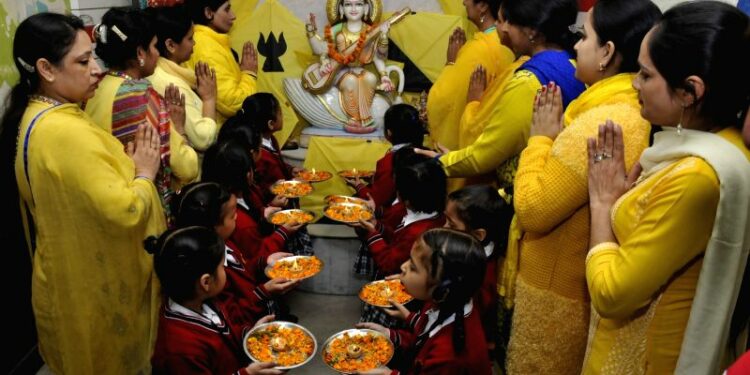Long before Valentine’s Day happened to India there was already a day which stands for love and devotion. Vasant Panchmi (or Basant Panchmi) the fifth day of the Magha month (Indian traditional calendar month) is though traditionally celebrated as a day of Goddess Saraswati in every part of India and several other countries, it is also the day of Kamadeva. It was on this day that Kamadeva played cupid to bring Lord Shiva and Parvati together.
The story goes such that grief-stricken Shiva had become ascetic and retreated to the Himalayas to meditate for penance after Sati (his first wife) immolated herself at her father’s palace. Parvati who was a reincarnation of Mahadevi and Sati in her previous life was born to King Himavat (King of Himalayas) and wife Menaka to fulfil her duties of the world and also to marry Shiva. Ever since her childhood Parvati was a devotee of Lord Shiva. When it was time for her to get married she told her parents that she would marry Lord Shiva. King Himavat who was also a staunch devotee of Lord Shiva agreed and took Parvati to the Himalayas where Shiva was meditating. After a long wait, Shiva opened his eyes and asked King Himavat about his purpose of visit. The father told Shiva about his daughter’s desire to marry him. Shiva did not even look at Parvati or consider the marriage proposal. However, on Parvati’s insistence, King Himavat left her behind to take care of Shiva’s place while he meditated. Years passed and Parvati worked hard but she couldn’t win over Shiva. Now the Gods decided to intervene and they approached Kamadeva (son of Lord Brahma) to act as a cupid to wake Shiva from his deep meditation and marry Parvati.
It was on Vasant Panchami that Kamadeva agreed and shot five arrows decorated with mango and jasmine flowers, Ashoka leaves, and buzzing bees from his heavenly sugarcane bow. One of the arrows distracted Shiva and for the first time he looked at Parvati and admired her beauty. However, soon after he regained his senses and got angry with Kamadeva for his mischief. He opened his third eye and reduced Kamadeva into ashes. The ‘God of Love’ was brought back to life after Shiv married Parvati.
Vasant Panchami also marks the beginning of the ‘spring’ a season which brings newness, freshness, colour, warmth and sunshine after the chills and glooms of the winter. It is the season in which flowers bloom, trees bear new leaves, birds sing and bees buzz. Every human being feels a new energy and warmth in his heart. This is also a reason that Vasant Panchami is celebrated as a day to remember your loved ones (spouse) and express love and emotions. In Maharashtra, it is a custom for the newlywed couple to wear a yellow dress on their first Vasant Panchami and offer prayer at a temple. In parts of Gujarat people decorate their house with bouquets and garlands of flowers and set it with mango leaves. They wear saffron or yellow outfits and sing songs of Krishna and Radha (the epitome of pure love). In Rajasthan, people wear garlands of sweet-smelling jasmine. In central India, people worship Shiva and Parvati and offer mango flowers and ears of wheat. It is also an auspicious day wherein marriages can take place irrespective of what the planetary/constellation positions.
In Bengal, the girls wear basanti saris, bindi and jewellery and men wear traditional kurtas. On Valentine’s Day, it is all about couples and if you are single, it is something to be ashamed of. But Basant Panchami is about feeling special with someone in the midst of friends and relatives. Compared to Basant Panchami, Valentine’s Day is shallow and without substance. It doesn’t have a spiritual or social content; it’s all about show of superfluous show of affection and lust.


















Discussion about this post